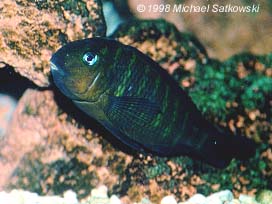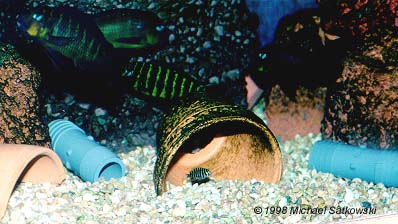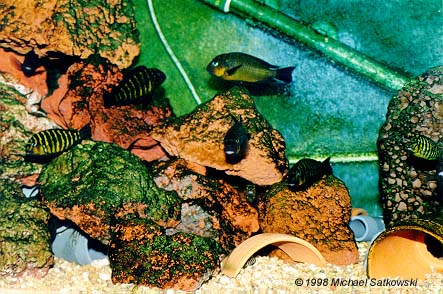I bought 20 Tropheus brichardi ‘mpimbwe’ from Jeff Black in April 1997. Actually, I had wanted T. dubosi, but he didn’t have any. I had a 75 gal just bubbling away, cycled and waiting for some fish, and Jeff showed me these little (2cm) striped guys and, well, you know the story, the next thing I know, I’m driving home with these fish in a bag.

I thought I had everything perfect: pH 8.6, hardness about 300ppm, temperature 80*F, gravel base, two piles of lava rock, one that was about a 10 inches high, the other about 2/3 to the top of the tank, two Whisper 3 filters. I fed them only green spirulina conditioning flake that I bought from Jeff.
They started dying three days after I got them.
First they would mouth the food without eating it, the next day they would hang back and not participate in the chow-time frenzy with their buddies, and then a day after that, two at the most, they would die. I checked the water: no nitrites, no ammonia. I changed water. I changed more water. They dropped one, two every day. I finally called up Jeff and asked him what could be wrong. He told me about ‘Clout.’ After one treatment cycle (with no feeding during the treatment) they appeared to be cured. Of course, by then I only had six left.
Being stubborn, I bought the 10 remaining Mpimbwes Jeff had and I tried again. While not experiencing the carnage of the first two weeks, over the next three months, I would lose a fish inexplicably. Finally, I settled in on a scheme that seemed to work for me: I mixed in 20 lb. of dolomite in the gravel, fed them a small amount of green flake 3 times a day, changed 40% of the water every five days (direct from the tap with Start Right water conditioner added first). If anybody hung back and didn’t eat for more than a day, I’d Clout the tank. Left with 12 fish after 6 months, they settled in with this routine and started to grow well. I changed brands of green food once and they got sick, but I added Clout and they all recovered. After that, I used only one brand of flake.
They would pick on each other somewhat, but the real fights got started after I had them about 10-11 months. They have this kind of Travis Bickle (the cabbie from the movie ‘Taxi Driver’) look to them. In a typical fight, one would present its side and another would take whacks at it, then they would switch positions. Occasionally, I would seen one with scales missing on its side or a little Tropheus bite mark in the nose. Lip locking duels would surge the length of the tank with pairs locked for 5 sec. Fighting kept escalating until one of the males drove (or at least tried to) everybody to one half of the tank except for one female. The pair would shimmy and circle each other a lot, but I never saw the eggs being laid. A day or two later she had a mouthful of eggs. She carried the eggs 32 days before the first baby was released. Finally, three total were released. As I didn’t want to destroy the rock pile, I let them release in the tank. One baby disappeared after a week, but the other two grew up fine on just flake crumbled and tossed in with everybody’s feeding. Over the next four or five months other females would hold eggs but would not carry them to term. During this time, the fighting peaked.

It’s not that that they were continually violent; they would be relatively peaceful (I mean they are Tropheus, after all) and then they would just get in the mood to really rumble. One day a saw a fish (one of the females) with its caudal fin shaved off completely. It loitered in a top corner, looking miserable. I tried to net it out, but even with no tailfin it was extremely fast and I couldn’t get it. However, she slowly recovered. In fact, the silly fish would try to pick on its undamaged tankmates. It was amazing to see this fish trying to start a fight with no butt. Of course it got clocked some more, but eventually grew its fin back. This happened twice more, and both times it appeared females were the victims. Both times they recovered their damaged or missing fins in a month. After I had them 17 months (about 8cm long), three females started holding. One of the larger females spit out four babies in the tank after 34 days. The fry instantly wolf down as much flake as they can hold.


My Tropheus B’s have a number of peculiar habits. One of the most annoying is that they will line up and watch any activity in the room they deem noteworthy. I will plunk down in my chair with a beer to watch the fish . I’m expecting to see these marvelous creatures interact, spawn, kick butt, whatever. Does this immediately happen? Nope. What happens is all 12 face toward me, suspended nearly motionless in the water, looking at me looking at them . All I get to see is their goofy noses pointed at me. This will continue for a few minutes until they decide the beer isn’t for them or just get bored of me watching them. Then they get back to trying to figure out who’s the baddest fish in the tank. Another one of their favorite ‘shows’ is my wife vacuuming the room. Sometimes they stop to stare at the dog sitting on the couch.

Another bad habit they have is that they like to splash when eating, and can toss a lot water out of the tank. Since the tank is in the living room near a new couch, this is tricky, especially when my wife is nearby. I have to raise the lid, toss the flake in and snap the lid shut in one deft motion. Since they see the food jar and instantly get primed to do belly flops, it’s not that easy. On the other hand, this behavior has an up side when we have bratty kids visiting that want to feed the fish.
This is the part of the report that is supposed to encourage others to raise these fish. Well, all I can say is that if you want a fish with the intra-species manners of a group of thugs, who are tough in some ways, delicate in others, here’s your fish. Just remember to pick up a big bottle of Clout.
Leave a Reply